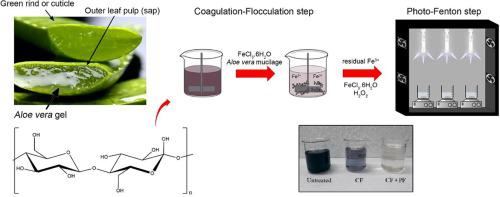Journal of Photochemistry and Photobiology A: Chemistry ( IF 4.3 ) Pub Date : 2022-04-08 , DOI: 10.1016/j.jphotochem.2022.113948 Franciele França Figueiredo 1 , Thabata Karoliny Formicoli de Souza Freitas 1 , Guilherme Gonçalves Dias 1 , Henrique Cesar Lopes Geraldino 1 , Ana Paula Jambers Scandelai 2 , Amanda Junkes Vilvert 1 , Juliana Carla Garcia 1

|
In this study, the mucilage of Aloe vera was used as a new auxiliary coagulant in pre-treatment using a combined system based on the photo-Fenton (PF) process for the treatment of textile effluents. Coagulation–flocculation (CF) using a combination of coagulants showed better performance in the elimination of turbidity, chemical oxygen demand (COD), dissolved organic carbon (DOC), and natural organic matter (NOM) when compared with a single inorganic coagulant. In addition, the combination of coagulants allowed a 28% reduction in the concentration of the inorganic coagulant used. To remove the dissolved and recalcitrant matter after CF, the pretreated effluent was subjected to a PF process that is efficient in the degradation and mineralization of dissolved organic compounds; this resulted in the elimination of 82.48% of COD, 80.34% of DOC, and 79.65% of NOM, as well as the formation of inorganic ions. The toxicity of the samples was evaluated base on three organisms of different trophic levels: Lactuca sativa, Artemia salina, and Eisenia fetida. The results showed that the samples treated by CF or CF/PF were non-toxic to A. salina and E. fetida. However, in the L. sativa bioassay, the root-growth parameter revealed toxicity in the effluents before and after treatment, excluding the untreated effluents with doses of 100 and 200 mL L-1 and the effluent with a dose of 100 mL L-1 treated by the CF process.
中文翻译:

在光-芬顿反应之前使用芦荟粘液作为天然凝结剂处理纺织废水
在这项研究中,芦荟的粘液使用基于光芬顿(PF)工艺的组合系统处理纺织废水作为一种新的辅助混凝剂进行预处理。与单一无机混凝剂相比,使用混凝剂组合的混凝-絮凝 (CF) 在消除浊度、化学需氧量 (COD)、溶解有机碳 (DOC) 和天然有机物 (NOM) 方面表现出更好的性能。此外,混凝剂的组合使所用无机混凝剂的浓度降低了 28%。为了去除 CF 后的溶解和顽固物质,预处理的流出物经过 PF 工艺,可有效降解和矿化溶解的有机化合物;这导致消除了 82.48% 的 COD、80.34% 的 DOC 和 79.65% 的 NOM,以及无机离子的形成。基于三种不同营养级的生物体评估样品的毒性:Lactuca sativa、Artemia salina和Eisenia fetida。结果表明,经CF或CF/PF处理的样品对盐藻和恶臭肠杆菌无毒。然而,在L. sativa生物测定中,根系生长参数揭示了处理前后出水的毒性,不包括剂量为 100 和 200 mL L -1的未经处理的出水和剂量为 100 mL L -1的出水CF 工艺处理。


























 京公网安备 11010802027423号
京公网安备 11010802027423号